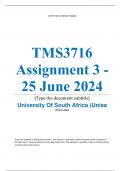[TYPE THE COMPANY NAME]
TMS3716
Assignment 3 -
25 June 2024
[Type the document subtitle]
University Of South Africa (Unisa
[Pick the date]
[Type the abstract of the document here. The abstract is typically a short summary of the contents of
the document. Type the abstract of the document here. The abstract is typically a short summary of the
contents of the document.]
, Exam (elaborations)
TMS3716 Assignment 3 (COMPLETE ANSWERS) 2024
(623358) - 25 June 2024
•
Course
• Teaching Home Languages in Senior Phase (TMS3716)
• Institution
• University Of South Africa (Unisa)
• Book
• Teaching and Learning Languages
TMS3716 Assignment 3 (COMPLETE ANSWERS) 2024 (623358) - 25 June
2024; 100% TRUSTED workings, explanations and solutions. ........
Question 1 1.1 According to the CAPS, what are the important features of an
oral presentation? (5 marks)
According to the Curriculum and Assessment Policy Statement (CAPS), the important features
of an oral presentation include:
1. Clarity and coherence: The presentation should be clear, well-organized, and easy to
follow. Ideas should be logically connected, and transitions between points should be
smooth.
2. Accuracy of content: The information presented should be accurate, factual, and
relevant to the topic. Students should demonstrate a solid understanding of the subject
matter.
3. Appropriate language use: The language used should be appropriate for the audience
and purpose of the presentation. This includes using formal language where required and
avoiding slang or colloquialisms.
4. Audience engagement: The presenter should actively engage the audience by
maintaining eye contact, using appropriate gestures and body language, and speaking
clearly and audibly.
5. Time management: The presentation should adhere to the allocated time limit. The
speaker should effectively manage time to cover all essential points without rushing or
exceeding the time limit.
,These features emphasize not only the content and structure of the presentation but also the
delivery and interaction with the audience, ensuring that the presentation is effective in
conveying information and maintaining audience interest.
1.2 Explain how you would use an audio resource such as a news bulletin, a
podcast and so on in your home language classroom to teach speaking and
integrate reading and writing with speaking in the lesson. a. speaking (4
marks) b. reading (4 marks) c. writing (4 marks)
a. Speaking (4 marks):
Using an audio resource such as a news bulletin or podcast can greatly enhance speaking skills in
the following ways:
• Listening and Speaking Practice: Start by playing the audio resource for students.
Encourage them to listen actively, taking notes on key points or interesting facts.
• Discussion and Debate: After listening, facilitate a class discussion or debate on the
topic covered in the audio. Encourage students to express their opinions, share insights,
and ask questions related to the content.
• Role-Play: Assign roles to students based on the characters or perspectives presented in
the audio. For instance, they could role-play as journalists discussing the news or as
experts debating a current issue.
• Presentation Practice: Have students summarize the main points of the audio in a brief
presentation to their peers. This exercise helps improve their ability to organize thoughts
coherently and deliver information effectively.
b. Reading (4 marks):
Integrating reading skills with audio resources involves:
• Pre-Listening Reading Task: Provide students with a brief overview or summary of the
topic covered in the audio resource. This primes them for listening comprehension and
helps activate relevant vocabulary.
• Transcripts or Texts: If available, provide transcripts of the audio or supplementary
reading materials related to the topic. This allows students to read along while listening,
reinforcing comprehension and vocabulary acquisition.
• Reading Analysis: After listening, assign reading comprehension tasks that require
students to analyze the content further. This could include identifying main ideas,
supporting details, or comparing viewpoints presented in the audio and related texts.
, • Vocabulary Development: Highlight key vocabulary words or phrases from the audio
and related texts. Encourage students to expand their vocabulary by using context clues
and making connections between spoken and written words.
c. Writing (4 marks):
Utilizing audio resources for writing skills can be approached in the following ways:
• Summary Writing: Ask students to write a summary of the audio content, focusing on
the main ideas and key points discussed. Emphasize concise writing and paraphrasing
skills.
• Opinion or Response Writing: Prompt students to write a personal response or opinion
piece based on the audio content. Encourage them to express their thoughts on the topic,
supported by evidence from the audio and related readings.
• Script Writing: Have students create a script for a radio broadcast or podcast episode
based on the topic of the audio. This exercise combines creativity with language skills,
focusing on dialogue and narrative structure.
• Reflective Writing: Encourage students to reflect on their listening experience. Ask
them to write about what they learned, any questions they still have, and how the audio
resource impacted their understanding of the topic.
Implementation Tips:
• Differentiation: Provide support for varying language proficiency levels by adjusting the
complexity of listening tasks and reading materials.
• Feedback: Offer constructive feedback on speaking clarity, writing coherence, and
reading comprehension to guide students' improvement.
• Integration: Emphasize the interconnectedness of speaking, reading, and writing skills
by highlighting how each skill reinforces understanding and communication in the home
language.
By integrating audio resources effectively in your home language classroom, you create dynamic
learning opportunities that enhance students' language proficiency across multiple skills while
engaging them with authentic and relevant content.




